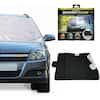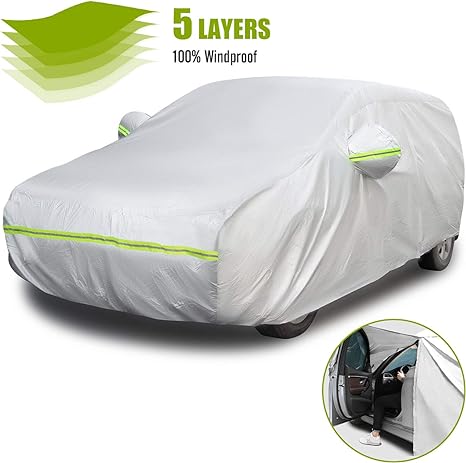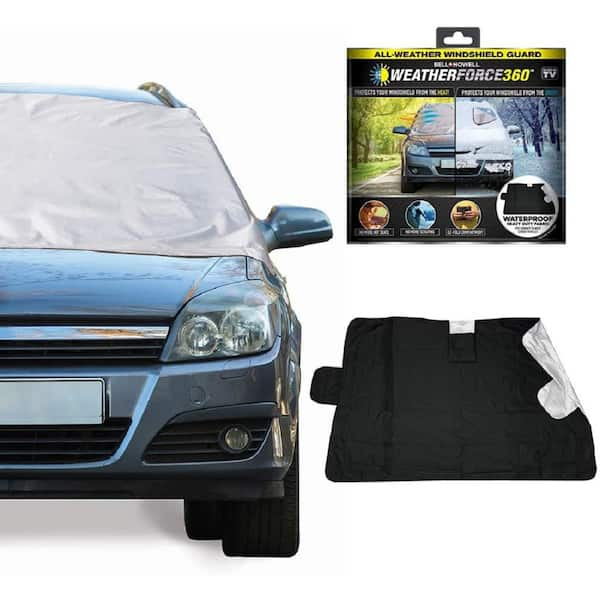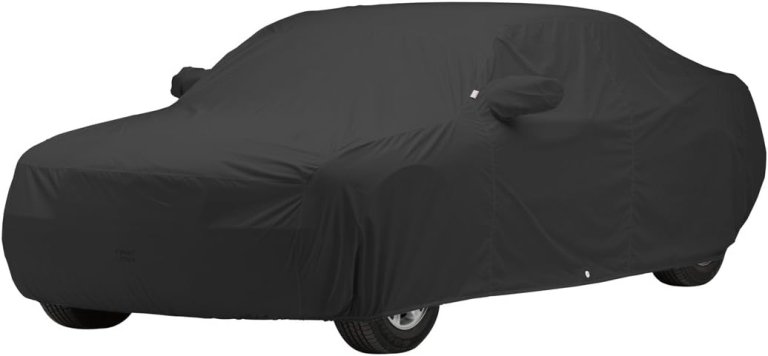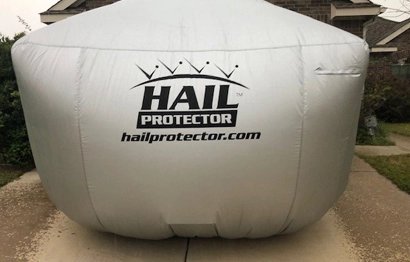We may earn revenue from the products available on this page and participate in affiliate programs. Learn more ›
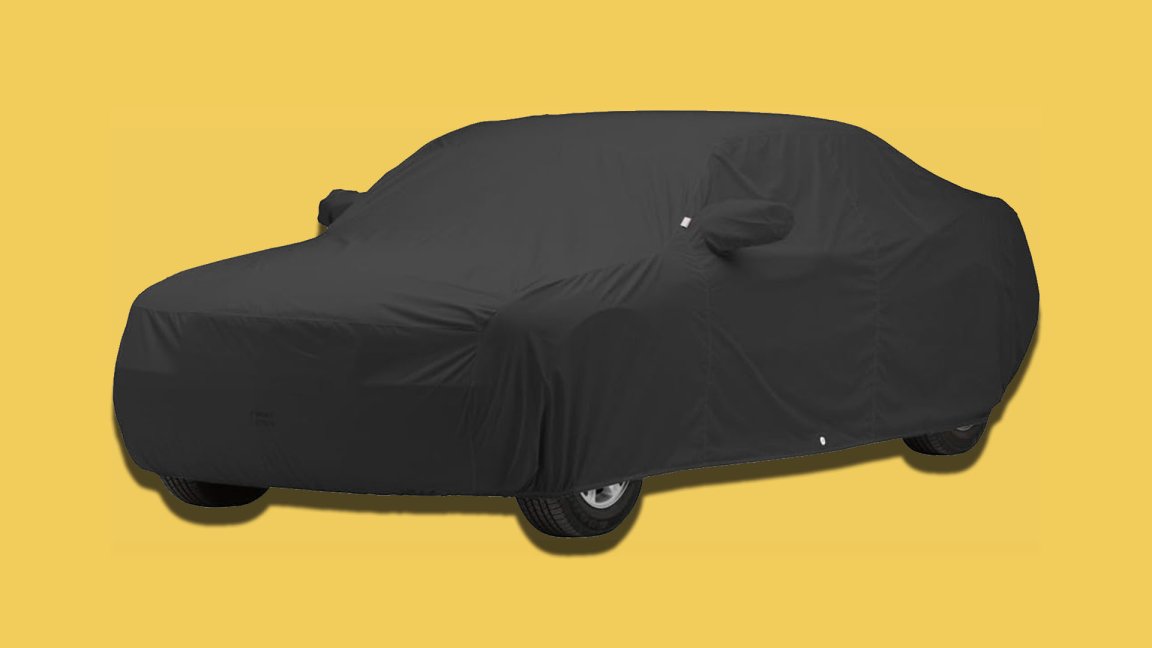
Mother Nature isn’t a fan of your car, SUV, motorcycle, or anything else you leave outside. She’ll wield the elements to grind it to dust and reclaim the raw materials for her own. As much as I get her motivations, I know keeping your things in shape is important to you as well.
That’s what car covers are for. While they can’t shield your car from everything, they can provide a protective barrier, saving it from minor brushes with the elements, dust, and more.
Not all car covers are the same, though. Each is designed to defend your car against different forces. Which is right for you really depends on where you live, how you store your car, and the conditions it’s subjected to in either situation. I might only get so far without those specific details, but I can still get you pointed in the right direction.
Summary List
- Best Overall: CarCovers.com Platinum Shield
- Best Value: Favoto Hatchback Car Cover
- Best for Windshields: Bell and Howell Weather Force 360 Reversible Windshield Cover Protector
- Best Indoor: Covercraft Custom Fit Car Cover
- Best for Hail: Hail Protector
Our Testing Methodology
Car covers aren’t as simple as they appear, but they are something we’re familiar with. This guide has grown over time, with input from various team members with deep industry experience. Some of the entrants below were even subject to hands-on testing that earned their place on our list. That said, we still reinforced our selection with plenty of research to ensure anything we recommend is worthwhile. As time passes, the list is also subject to change.
Best Car Covers: Reviews & Recommendations
Best Overall: CarCovers Platinum Shield
Pros
- Semi-custom fit by year, make, and model
- Can be used outdoors or indoors
- Patented gust strap wind protectors
Cons
- Costs more than universal fit car covers
- Tie-downs are not as easy to use as buckle-type straps
Firstly, yes, the Carcovers.com Platinum Shield does cost more than our other universal covers. At the time of writing, it’s offered at $194.95. However, the reason it takes our top spot is that it offers an excellent fit and high-quality material, making it worth the investment.
The cover came loosely folded for easy installation, along with a drawstring storage bag that’s large enough that you can actually put the cover back into it, even if it’s not folded as neatly as when it originally came from the factory. The material was thicker and more supple than our other universal contenders, and it featured a soft fleece layer where the cover met the paint for added protection against scratches.
Semi-custom covers aren’t a perfect fit, but the Platinum Shield was much better than the other universal covers we tested here. The lack of mirror pockets is actually a plus too, as it gives the cover a shape that helps sheds water away from the car and allows for some ventilation.
The cover’s generous elastic hem can be tucked up under the body, and the cover itself falls at the right height over the wheels. We didn’t subject the covered car to the same severe weather conditions as some of the others (it missed out on the snow), but the Platinum Shield cover comes with hold-downs just in case.
Best Value: Favoto Hatchback Car Cover
Pros
- Hatchback contour for better fitment
- Driver side zipper seam for easy entry and cover removal
- Weatherproof fabric
Cons
- Tie-down straps require tying knots to secure the cover
- Fabric stiff in frigid temperatures
The heavy-duty, five-layer material put up a strong defense against rain, ice, and snow in testing. After a deep freeze and 5-degree morning, the hatchback cover was slightly stiff but held together during removal.
Favoto gave the cover reflective strips on the front so you could see it in the dark, mirror pockets, and had “rear” emblazoned on the end which served as a guide as to which end is which. This specific cover also has a driver-side zipper seam for easy access to the cabin without having to remove the entire cover.
The cover had tie-down straps on each corner, but they were just sewn-on straps and tying up knots in near-zero degree weather left us wishing for quick-release buckles. The Favoto and AmazonBasics covers were very similar, but the buckle straps put the AmazonBasics cover one click up.
Best for Windshields: Bell and Howell Weather Force 360 Reversible Windshield Cover Protector
Pros
- Security panels flap
- Compatible with any car
- Tear-proof and machine washable
Cons
- Should have more magnets
- Cumbersome to handle
Sometimes you don’t want to deal with a huge bulky cover that goes over your entire car. This windshield cover protects what’s important. The reversible design means you can use it throughout the year. Put one side out, and it will reflect the sun’s UV rays to keep your car feeling cooler. Flip the cover over during the winter and protect your car from ice and snow. To keep your cover on your car, there are two security panels that you’ll close the front doors over. The tear-proof fabric means this cover can take a beating and won’t come apart. Then, if your cover gets gross, throw it in the washing machine, and it’ll come out looking beautiful.
Unfortunately, while there are magnets to hold the cover in place, they could be stronger, or there could be more of them. They are strong enough for light wind but won’t hold up in a heavy storm. The cover can also feel cumbersome to handle because of its weight and size.
Best Premium: Covercraft Custom Fit Car Cover
Pros
- Custom fit ensure snug application
- Velvety underside keeps your paint pristine
- Well-known manufacturer
Cons
- Expensive
- There are some reports that some model refreshes don’t quite fit with the covers
- Long wait time for cover to arrive
Covercraft is one of the most well-known brands in the car cover industry. The company has been making car covers since 1965 and has specialized in all sorts of car covers, including this indoor car cover. This particular model is custom-sized for a Cadillac CTS, but you can find your specific make and model fairly easily either through Amazon or Covercraft’s website.
The cover itself is made of polyester and has a velvety underside to keep your paint looking pristine. It’s also water-resistant, so if you have a leaky garage or someone spills something on it, it won’t touch your paint, so long as you notice it somewhat quickly. We didn’t test this specific car cover as the company doesn’t make one to fit our…interesting cadre of vehicles, but its long-standing reputation for providing great products sealed our recommendation.
Best for Hail: Hail Protector
Pros
- Not many covers protect from hail
- Comes with cellphone app
- One-year part and labor warranty
Cons
- Long setup time
- Expensive
- Need to know hail is coming
Hail Protector, a balloon that’s been mutated by science to encapsulate your prized possession and ensure its continued factory-contoured curves. The system works by combining a small blower motor that inflates the car cover in about 5 to 8 minutes — depending on the power source chosen — with a smartphone app that tells you when hail is imminent or in the forecast so you can blow it up ahead of time. The cover has been tested up to 60 mph winds and is resistant to UV rays, rain, and dust to keep your paint looking pristine.
Now, unlike the others, we didn’t put the Hail Protector through its paces as we did with a handful above, but that’s because there weren’t any hail storms predicted in our immediate future and we’d just run out of golf balls. What we can say is that enough folks that we trust have told us the benefits and drawbacks of the Hail Protector and we feel confident enough to suggest you take a gander if your area suffers routine hail storms. It can, however, be a bit of a pain to set up and eight minutes is a long time to wait if you miss the notification that hail’s coming.
Our Verdict on the Best Car Covers
Testing and research conclude that the CarCovers Platinum Shield cover is the best choice overall. It’s a preimium quality piece that held up well under rigorous testing in New England. However, you can still get a decent product and save some money by going with the Favoto Hatchback Car Cover.
Features to Know Before Buying a Car Cover Key Features
Fitment
Car covers come in custom or universal sizes. Universal covers are more affordable and more readily available than custom covers, which often have longer turn around times. The tradeoff being that a custom car cover is going to offer far better protection and won’t slide around as much, which can cause further damage to the paint.
Anchoring Points
How the car cover secures the car is another major detail to consider. Many use light-duty elastic tethers that simply won’t hold up in harsh conditions. If you’re in an area that’ll subject the cover to rough weather, you want to make sure it has sturdy reinforced tie-downs that will withstand those forces.
Primary Material
And lastly, material is a factor. Where you live and where your car is stored are the two most important factors in choosing a material that offers the most protection. Indoor car covers don’t need to fight the elements and are made of softer fabrics. Outdoor covers range from single-layer water-resistant fabric to multi-layer weatherproof material that’s more like a tarp than a windbreaker. Look for breathability with outdoor covers. You don’t want to wrap your car up like a steak in plastic wrap.
Types of Car Covers
Indoor
Indoor covers are ideal for keeping a car safe from dust and little else. The barrier may protect it from light bumps and scratches but won’t do very much for UV rays or moisture. In fact, they are designed to allow moisture to pass right through so as not to trap it beneath and create rust or mold issues.
Outdoor
If you’re storing a car outdoors, an outdoor cover is the obvious match. Unlike they’re garage-bound alternative, these do offer more protection against UV rays and moisture. How much protection really depends on the cover you invest in, with more protection generally driving up the cost on account of premium materials.
Car Cover Pricing
Car covers range from under $20 to over a thousand dollars for your top-spec, OEM-produced supercar covers. Solid, middle-of-the-range models will likely set you back under $200.
FAQs
You’ve got questions. The Drive has answers!
A. Only if neglected. A dirty, low quality, worn out, ill-fitting, or improperly fastened car cover can scratch or scuff the paint. Dirt trapped in between the car and the cover acts like sandpaper. Wind whipped fasteners and tie-down straps can slap against the paint like loose rope hitches on a flagpole, too.
A. Yes, most outdoor covers can also be used indoors. Make sure both sides of the cover are thoroughly clean and dry. Breathable fabric is important. You don’t want the cover to trap moisture inside the car during indoor storage.
A. The same way you wash a car. Rinse first and use car wash soap to remove crud and grime. Rinse again, reverse the car cover, and repeat. Hang dry. Some indoor car covers can be machine washed but check with the manufacturer first.
If moisture is trapped underneath the car cover, rust may occur. This is an issue you might run into if a vehicle is stored outdoors with covers on for long periods of time, but it can be prevented by periodically inspecting the vehicle to ensure it’s dry and moving it to a new space if necessary.
Yes. However, it’s important to be aware that repetitively dragging a cover over the paint raises the potential for scratches, and you should act carefully.


